|
|
|
kalu nak tau lebih lanjut mengenai atlantis tgk je cite kartun toriton. |
|
|
|
|
|
|
|
|
|
|
|
toriton dh dtg... |
|
|
|
|
|
|
|
|
|
|
|
aku x tau sgt psl atlantis...tp aku rasa mesti sebuah kota/tamadun yg hebat...
orang2 dulu mmg byk kepakaran...
cuma aku nk tanya korang yg tau...kisah istana balkis tu dipindahkan...ada org ckp yg pindahkan tu manusia..betul ker...teknologi apa dia pakai erk...sampai ifrit pun surrender.. |
|
|
|
|
|
|
|
|
|
|
|
|
Aku tak caya sangat lah pasal cerita Atlantis ini. Ini semua Myth belaka:stp: |
|
|
|
|
|
|
|
|
|
|
|
Originally posted by pisang69 at 5-1-2006 02:40 PM
aku x tau sgt psl atlantis...tp aku rasa mesti sebuah kota/tamadun yg hebat...
orang2 dulu mmg byk kepakaran...
cuma aku nk tanya korang yg tau...kisah istana balkis tu dipindahkan...ada org ckp ...
seorg hamba Allah yang kuat dan beriman dengan Allah... |
|
|
|
|
|
|
|
|
|
|
|
boleh jadi zaman atlantis ,
mempunyai hubungan ngan tamadun mesir dan segi3 bermuda :hmm:
sebab yang aku tau dalam piramid ader ukiran yang pelik seperti helikopter,
ini menunjukan kedua tamadun amat maju |
Rate
-
1
View Rating Log
-
|
|
|
|
|
|
|
|
|
|
|
Atlantis in history
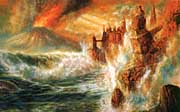
In Part I of our series on legendary Atlantis, we explored Plato's voluminous tales of the ancient island empire. One of the primary sources of information we have on Atlantis is Plato's Timaeus, one of two works of Plato that mentions Atlantis. Timaeus is the story of an Athenian Greek philosopher named Timaeus who was the keeper of an oral tradition involving Atlantis. This oral tradition had started hundreds of years earlier when Solon, a famous Athenian traveler, poet, and lawgiver, had met an Egyptian priest of the goddess Neith while traveling in the Sais district in lower Egypt. Solon, who had gone to Egypt to impress the Egyptians with the wisdom of the Greeks, found himself greatly outmatched by the wisdom of the Egyptians, to whom the Greeks were as children by comparison.
The oral traditions of the Greeks, Solon was to learn, even though they were centuries old, were relatively new compared to the traditions of the Egyptians, whose roots stretched back thousands of years. However, Solon also learned from the Egyptian priest that the Athenian Greeks had actually been in existence before the Egyptians |
Rate
-
1
View Rating Log
-
|
|
|
|
|
|
|
|
|
|
|
Atlantis : The Theories
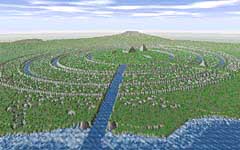
The capitol of Atlantis, as described by Plato
Many have conjectured on the location of Atlantis. Was it in the middle of the Atlantic, "west of the Pillars of Hercules", as Plato and Cayce had posited, or was it in a myriad of other places that have been suggested over the last few decades as the increase in knowledge and in travel has expanded man's ability to seek out and explore ancient civilizations? North America, Central America, South America, Cuba, the Yucatan, ancient Crete, even island chains in the Pacific have been posited as the sunken remains of fabled Atlantis. Atlantis - The Lost Continent Finally Found has a very thorough checklist covering all of the places theorized as the location of Atlantis. Though much of the analysis in this site and some other books and websites disagree with much of what we have found in our analysis of Atlantis and its probable location, let us go through some of the most popular destinations and see what interesting ideas are fulminating out in the controversial field of Atlantean research:
The Caribbean
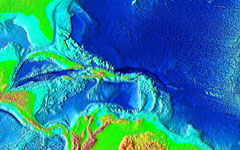
false-color satellite photo showing actual extent of the Caribbean and surrounding islands beneath sea level. A lowering of the sea level of a few hundred feet would expose a large amount of land in the Caribbean, making it more of a small continent than a collection of islands.
One of the most popular and well-supported theories for the location of Atlantis is in the Caribbean. Edgar Cayce believed that the Caribbean Islands are the partly drowned remnants of one of the islands that the Atlanteans emigrated to after the main continent of Atlantis began to suffer the destructive effects brought on by the wars of the children of Belial. This was around the beginning of the Ice Age, around 50,000 b.c., when most of this area was indeed above water. At this time the islands of the Caribbean, along with Cuba, were all part of a larger land mass that was connected with Central America via the Yucatan peninsula, and possibly with North and South America as well. As Shirley Andrews explains in Atlantis: Insights from a Lost Civilization,
During the most recent Ice Age, from 50,000 B.C. until 10,000 B.C., so much water from the oceans was incorporated into the snow and ice of the glaciers, that they grew to be a mile-high in some places. As a result, the Atlantic Ocean was approximately 350 feet lower than today and most of the continental shelves were above the surface. The continental shelves extend out as far as two hundred miles from the present shore lines of America and Europe. Land areas in the North Sea, the English Channel, as well as much of the Caribbean area were also above the surface of the ocean during the last half of the Ice Age. Atlanteans moved to all of these areas, for the land was more stable than the Atlantic Ridge. Since the ocean was lower, additional shorelines were exposed, so islands were larger and therefore closer together. It didn't require a large, complicated boat to sail from one place to another. The Bahama Islands consist of about seven hundred small islands and cays. They extend from fifty miles east of Palm Beach, Florida for approximately 760 miles southeast in the direction of Haiti. When a large amount of ocean water was incorporated in the glaciers during the Ice Age, the entire region, which is known as the Bahama Bank, was above sea level. It is clearly visible on a map which depicts the ocean floor. During the Ice Age, the Yucatan peninsula of Mexico stretched out nearly to Cuba, which was a larger island than today, and the Key West chain of islands was a land bridge that stretched almost to the northern coast of Cuba. A long mass of land, with only two or three breaks for rivers, ran from Jamaica, across what are now the Lesser Antilles Islands and continued all the way to Venezuela. Atlanteans thrived in all these areas.
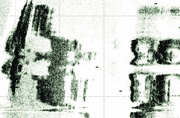
One of the "sunken city" images taken off the coast of Cuba by Advanced Digital Communications, a company that had been hired by the Cuban government to search for oil deposits and sunken ships off the southwest coast of Cuba. This image clearly shows manmade structures some 2,200 feet below the ocean surface, proving that inhabited land masses have indeed sunk in the past as Atlantis is said to have done.
In July of 2000, as discussed in detail in the Fragments article, Atlantis Off Cuba? earlier in this issue, a commercial expedition found several large, manmade structures 2,200 feet below the surface of the Gulf of Mexico, southwest of Cuba, near the Yucatan Peninsula. This was approximately where Cayce predicted such structures would be found around the turn of the millennium, around which time he believed Atlantis would begin to rise again. Other structures that support Cayce's belief that the Caribbean was once a major center of Atlantean habitation include the controversial "Bimini Road", that was found in 1968 near the island of Bimini, an area which Cayce identified as the place where many Atlanteans fled after the first destruction, ca. 50,000 b.c.2
More support for the "Atlantis in the Americas" theory has been developed by authors Ivar Zapp and George Erickson, who believe Atlantis was located around the area of the Caribbean and Central America. Besides the highly developed architecture of the Inca, the Maya, and other ancient cultures of the Americas, one of the more interesting proofs of an ancient, sophisticated maritime civilization that Zapp investigated was the discovery of hundreds of stone spheres in the Diquis Delta region of Costa Rica. These stones were |
Rate
-
1
View Rating Log
-
|
|
|
|
|
|
|
|
|
|
|
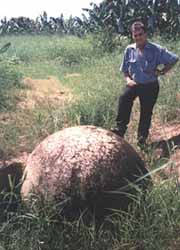
Ivar Zapp standing astride one of the hundreds of stone spheres dotting the landscape around the Diquis Delta region of Costa Rica. Authors Zapp and Erickson believe that these stone spheres, which point to major neolithic sites around the world, sat at the heart of a major maritime culture
precisely machined to within a thousandth of an inch of perfect sphericity,measured up to nine feet in diameter, and weighed as much as twenty tons. Zapp, a professor of architecture, decided to accept their existence, unlike his archaeological predecessors who dismissed the stone spheres as "out of context" and tried to forget them as they did not agree with their preconceived notions of the area's history. Zapp had initially visited the area of Costa Rica on a field trip with some of his students in order to investigate the purpose of the stones, and they discovered that these enigmatic stone spheres were actually arranged in patterns that appeared to point to other megalithic structures around the world.
Professor Zapp and his students first studied the layout of the spheres that remained in situ [and] found that, in most cases, the stones were arranged in groups of threes forming a triangular configuration. Ivar noticed that an axis line formed between two major groups of the spheres was oriented to the magnetic north pole, indicating that the builders had a knowledge of the magnetic compass.... Using a globe ... Ivar found that the 19 degree southwest inclination of the line that intersected [certain spheres] projected from the Palma Sur site in the Diquis Delta leads to Cocos Island, to the Galapagos Islands, and then to Easter Island. [Another line] leads to the straits of Gibraltar, and if projected southwest, leads to the Marquesas. In another group the axis leads to the Great Pyramid of Giza. In another, it leads to Stonehenge. In every case, the megaliths of Costa Rica pointed to great megaliths of distant lands and islands.3
Interesting reports of ancient Atlantean crystal technology in the Caribbean also surface from time to time. Geoffrey Keyte in The Millennium Matters' interesting website describes a strange event that occurred in the early 1970s when a man by the name of Dr. Ray Brown went scuba diving near the Bari Islands in the Bahamas. During one of his dives, he came across a pyramidal shape with mirror-smooth surfaces, and went to investigate:
Swimming around the capstone, which Brown thought might have been lapis lazuli, he discovered an entrance and decided to explore inside. Passing along a narrow hallway, Brown finally came to a small rectangular room with a pyramid-shaped ceiling. He was totally amazed that this room contained no algae or coral growing on the inner walls. They were completely spotless! In addition, though Brown had brought no torch with him, he could nevertheless see everything in the room with his normal eyesight. The room was well lit, but no direct light source was visible. Brown's attention was drawn to a brassy metallic rod three inches in diameter hanging down from the apex of the center of the room and at its end was attached a many-facetted red gem, which tapered to a point. Directly below this rod and gem, sitting in the middle of the room, was a stand of carved stone topped by a stone plate with scrolled ends. On the plate there was a pair of carved metal bronze-colored hands, life-sized, which appeared blackened and burnt, as if having been subjected to tremendous heat. Nestled in the hands, and situated four feet directly below the ceiling rod gem point, was a crystal sphere four-inches in diameter. Brown tried to loosen the ceiling rod and red gemstone but neither would move. Returning to the crystal sphere, he found, to his amazement, that it separated easily from the bronze hand holders. With the crystal sphere in his right hand he then made his way out of the pyramid. As he departed, Brown felt an unseen presence and heard a voice telling him never to return! Fearing, rightly, that his unusual prize might be confiscated as salvage-treasure by the American Government, Dr. Brown did not reveal the existence of his strange crystal sphere, nor did he relate his experiences until 1975, when he exhibited his crystal for the first time at a psychic seminar in Phoenix. Since that time, the crystal sphere has made only a very few public appearances but on each occasion people who have seen it have experienced strange phenomena directly associated with it.4
Psychics are of course fascinated with Atlantis and the Atlantean crystal technology. Shirley Andrews describes in Atlantis: Insights from a Lost Civilization the visions of two psychics who explored the area around Bimini that are strikingly similar to the biblical account of the fallen angels and how they interacted with mankind. Their visions referred specifically to the Atlantean women who had fled to what is now the Bimini area:
Two psychics, who assisted Dr. Zink in his research in Bimini, related that highly evolved, loving extraterrestrial beings from the Pleiades, perceiving the spiritually advanced residents of Murias, joined the thriving commercial and religious community and assisted with the construction of temples and buildings. The psychics relayed that the highly evolved priestesses who presided over the unique temple, developed an extensive variety of invaluable medicinal potions derived from flowers, herbs and other vegetation for use as healing remedies for those who came for help and advice.5
This is particularly good evidence backing up the Bible's and the Book of Enoch's descriptions (as we saw in Part II of this series) of how fallen angels had interacted with women before the Flood, as it specifically mentions the fact that these beings had taught mortal women the knowledge of how to use medicinal herbs for healing and other uses, just the fallen angels had done. Krista M. Baker explains in "Watchers/Nephilim (Naphidim)", "Once they reached the earth ... the Angels then taught women charms, enchantments, the cutting of roots, and the knowledge of plants."6 As a side note, these beings described themselves as being from the Pleiades, a common place that UFO aliens are believed to come from, but that is a story for a different time.
Despite these amazing discoveries the Caribbean, though certainly an important part of Atlantean history, was not Atlantis. It was instead either one of the areas that the Atlanteans fled to after the First Great Destruction of Atlantis, around 50,000 b.c., or possibly one of the western islands mentioned by Plato that were under Atlantean rule from the beginning, but not actually part of Atlantis proper. In either case, the bulk of these islands also sank beneath the waves at the end of the last Ice Age (around 10,000 b.c.), forcing the Atlanteans to emigrate further west. Cayce (and others) believe that the red races of the Americas are actually descendants of these Atlanteans who intermarried with the native inhabitants who preceded them, leaving behind a legacy of magnificent architecture and amazing astronomical and calendrical knowledge, among other things. And what of the crystal "firestones" that the Atlanteans left behind on these islands, one of which may have actually been seen? Some believe they are the cause of the many strange occurrences and disappearances in the Bermuda Triangle, which encompasses this entire area. More on this in future articles also. |
Rate
-
1
View Rating Log
-
|
|
|
|
|
|
|
|
|
|
|
Antartica
Another popular but less well supported location for legendary Atlantis is Antarctica. The primary proponent of this theory is an author by the name of Rand Flem-Ath, who is actually supported in this belief by such noted authors as Graham Hancock and John Anthony West. Flem-Ath believes that Atlantis did not actually sink, but instead was moved south as a result of a crustal displacement, in which the entire surface of the earth was moved. Atlantis, now located at the south pole, then disappeared beneath a tomb of ice, which caused much of the continent to sink under its weight, other parts of the continent being covered by the rising waters at the end of the Ice Age.
The present shape of Antarctica as depicted is based upon the current ocean level, not that of 11,600 years ago. Atlantis did not actually sink beneath the waves. Instead, as the old ice caps melted, the ocean level rose, covering some of the continent's permutations. Further distortions in our modern map, compared to Kirscher's are a result of the weight of today's Antarctic ice sheet. This immense blanket of snow and ice depressed parts of the continent, causing more and more land to fall below ocean level. Nevertheless, the shadow of Atlantis can still be seen in the modern map of Antarctica.7
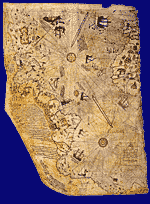
The Piri Reis map. Piri Reis was a famous admiral of the Turkish fleet in the sixteenth century who had a passion for cartography. The map shows an ice-free Antarctic continent, which Flem-Ath believes helps prove his theory that Atlantis is actually Antarctica.
Unfortunately, though the theory is interesting and well presented, it is not supported by the primary Atlantis references that specifically mention the location of this antediluvian continent: Plato, and Edgar Cayce. Plato specifically mentions that Atlantis was located west of the Pillars of Hercules, not thousands of miles south, as Flem-Ath and his supporters believe. They paper this statement over by saying that Plato's description of Atlantis as being "beyond the Pillars of Hercules" is actually a more of a generic reference. "A common mistake in most readings of Plato, Flem-Ath believes, is the inappropriate attempt to interpret the ancient account in the light of modern concepts. Another example, is the familiar reference to the Pillars of Hercules, beyond which, Atlantis was said to reside. While it is true that the term sometimes referred to the Straits of Gibraltar, another, equally valid interpretation is that it meant the limits of the known world."8
However, the text clearly says "in front of the straits which are by you called the Pillars of Heracles", and the Pillars of Hercules have been well-known landmarks for millennia. Moreover, Plato described Atlantis as a relatively close waypoint for those making a trip from the Mediterranean to what we now know as North and South America, which Antarctica clearly is not. Also, as we have seen, Cayce clearly stated that one of the Atlantean islands that survived the First Great Destruction was located in the Caribbean, which is also due west of the Pillars of Hercules. So for these and a host of other reasons to voluminous to get into here, Flem-Ath's theories are interesting, but fundamentally flawed. |
Rate
-
1
View Rating Log
-
|
|
|
|
|
|
|
|
|
|
|
Bolivia..
Recently an interesting solution to the Atlantis question has been put forth. Bolivia, or "Atlantis in the Andes", has been chosen as the location of Atlantis by author James Allen, who believes that the whole of South America is that lost continent, and that the Pampa Aullagas, a low mountainous area high in the Bolivian Andes at the south end of Lake Poopo, was once its capitol. Despite the unlikelihood of this premise at first blush, Allen makes some very powerful arguments, including the fact that the Pampa Aullagas is shaped much like the central city described by Plato, with rings of earth alternating with rings of water. Also, nearby is the Bolivian Altiplano, a very large, high plain, which is a very good match for the "rectangular and oblong" plain described by Plato that served as the breadbasket of Atlantis. Yet another excellent correlation is the abundance of gold, silver, copper, tin and orichalcum in the Andes, a combination of metals which is very rarely found in the same place, orichalcum being particularly rare.
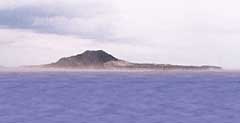
Pampa Aullagas at the southern end of Lake Poopo, high in the Bolivian Andes. In the wet season, Pampa Aullagas becomes an island, looking much like the central city of Atlantis as described by Plato. Allen believes that the record of the sinking of Atlantis is a memory of the severe flooding this region occasionally suffers
It was not the continent of Atlantis which sank into the sea, but the island capital of the same name, built around a volcanic island which sank into the inland sea of Lake Poopo which exists on the edge of the rectangular plain presently called the Bolivian Altiplano. This plain is in the centre of the continent exactly as Plato described it. Modern satellite mapping shows it to be of rectangular configuration, perfectly level, enclosed on all sides by mountains and these mountains contained the metals gold, silver, copper, tin and the mysterious "Orichalcum" (an alloy of gold and copper which occurs only in the Andes) which Plato said were used to plate the walls of the circular city. The words "Atl" and "Antis" are themselves of native America origins meaning "water" and "copper" respectively and the plain is subject to earthquakes and floods such as Plato said sank the city in a single day and night of rainfall.9
The combination of factors, including the shape of the Pampa Aullagas, the nearby Bolivian Altiplano, and the presence of the rare orichalcum and numerous other precious metals make for a very strong argument in favor of Atlantis in the Andes. Cayce, however, believed the the area around Bolivia, Peru and Chile, what is now western South America, was actually a colony of Atlantis, rather than being Atlantis itself. Moreover, the orichalcum could have easily been mined and shipped back to Atlantis to be used there |
Rate
-
1
View Rating Log
-
|
|
|
|
|
|
|
|
|
|
|
Sardina
Sunny, exotic Sardinia has also been proposed as a potential location for Atlantis. Located west of both Greece and Egypt, Sardinia was a militarily powerful state between 2000 and 1400 b.c. This fits into the same time period suggested above as the island of Santorini in Crete, where if one changes 9,000 years to 900 years, the actual time of the destruction of Atlantis was around 1500 b.c. Robert Ishoy explains his thesis in Atlantis Discovered:
My hypothesis is that Atlantis was a powerful state that was based on the island of Sardinia in the Western Mediterranean Sea. This powerful state was most fully developed in the pre Bronze Age and the early Bronze Age, say about 2000 BC to 1400 BC. These dates are supported by A. G. Galanopoulos' adjustments to Plato's time period for Atlantis. It is also my belief that Atlantis controlled much of the rim of the Western Mediterranean and even made attempts to conquer the highly developed states of the Eastern Mediterranean including; Mignon Crete, early Hellenes Greece and Egypt. This would mean that Atlantis was primarily a sea power. Perhaps the earliest great sea power in history. But according to Plato Atlantis was defeated in their invasion attempt of the East by a combination of the Athenian navy and major earthquakes and floods. Together these forces lead to the destruction of Atlantis as a major power. The defeat of Atlantis caused a major set back in the development of the cultures of the Western Mediterranean. However with new research the history of the Western Mediterranean may prove to be much richer than previously thought.
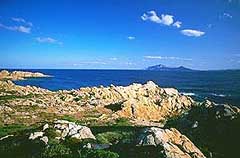
Sardinia, a large island 120 miles west of Italy, is believed by some to be the site of legendary Atlantis. However, though like Santorini, cultural similarities can be seen, the size, location and geography are still substantially different than that described by Plato.
Again, though interesting, the Sardinia theory does not fulfill the primary criteria set forth by Plato and corroborated by Cayce: a very large continent in the Atlantic Ocean, west of the Pillars of Hercules. Also, Sardinia was never powerful enough to pose a serious threat to either Greece or Egypt, let alone both Greece, Egypt and all of Europe and Asia, and furthermore, Sardinia never sank. Despite this, Atlantis-themed hotels and boat tours are available on the island and in nearby Sicily.
Having analyzed all of the major theories on the location of legendary Atlantis, and also some minor ones, we have found all of them to be unsatisfactory in one way or another. The Caribbean, though it definitely played an important role in Atlantean history, was not Atlantis, but one of its colonies. Antarctica is, of course, obviously not Atlantis, though it might host its own interesting antediluvian civilization. Bolivia, surprisingly, emerges as one of the best candidates in the group we have looked at so far, as it incorporates many of the major geographical and cultural features described by Plato, though it too is an imperfect match. Crete and Santorini are both islands that were inhabited since ancient times with cultural histories that were similar to that described by Plato, but neither were ever large or powerful enough to match the descriptions of Atlantis, and neither are located in the place where Plato placed Atlantis. The India-Atlantis theory, of course, is so unlike the Platonic account that it does not need further discussion, but it is interesting enough to merit some attention, if only to learn that there was more to the antediluvian world than just Atlantis.
So what's left? Is there a single location on Earth that matches the classical Platonic and Caycean accounts of Atlantis? Is there an appreciable land mass in the Atlantic, or some sort of remnant of same west of the Pillars of Hercules, that could be seen as the remnants of legendary Atlantis? In fact, there is |
Rate
-
1
View Rating Log
-
|
|
|
|
|
|
|
|
|
|
|
|
diorang ni takde keje ke..main speculate je.. |
|
|
|
|
|
|
|
|
|
|
|
aritu tgk dalam discovery channel dah jumpa atlantis iaitu diatas benua amerika latin.Pluto ade cakap kawasan atlantis berada di segi empat dlm kawasan yg luas dan beliau tunjukkan bukti tersebut.
pssst Atlantis tu satu nama yang menarik |
Rate
-
1
View Rating Log
-
|
|
|
|
|
|
|
|
|
|
|
Reply #57 weta_studio's post
|
kat mana exacty kat amerika latin ni...takkan diorang tak mention specific location..kalu takde mesti menipu je tu.. |
Rate
-
1
View Rating Log
-
|
|
|
|
|
|
|
|
|
|
|
The First Great Age Of Atlantis: Foundation to 50,000 B.C
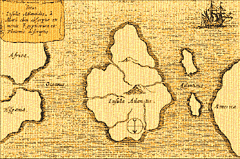
A classical portrayal of the island of Atlantis, based upon Plato's dialogues. This image was taken from an ancient map, which was originally drawn so that, compared to modern maps, all of the continents are upside down, with Europe on the left, and North America on the right. Assuming that the ancients also equated true north with the top of their maps, this helps to further confirm the pole-shift hypothesis as seen by Cayce and confirmed by modern science. Note also the islands between Atlantis and North America, located where America's East Coast now resides, supporting Cayce's statement that America's East Coast formed the lowlands of Atlantis. From Mundus Subterraneus by Athanasius Kircher. (1665)
In Cayce's visions, the geography of the world at the time when human history began on Atlantis was dramatically different than it is today. Many areas of Earth that today are ocean were once dry ground, and many places that were once lush and fertile are now desert. Most of Europe was underwater, Norway and the Caucausus forming the western boundary of what we now call Eurasia, their rivers flowing into the Atlantic. Of what is now America, only the desert southwest and high plains areas of Arizona, Utah and Nevada were above ground, the Midwest being entirely underwater, and the East Coast forming the lowland areas of the continent of Atlantis. Likewise the Nile flowed west across the Sahara into the Atlantic, instead of north into the Mediterranean. The desert areas that are now the Sahara and Mongolia were lush, fertile plains, the area now known as the Sahara being the cradle of humanity. However, though these differences were dramatic, the most dramatic difference of all, according to Cayce's readings, was that the Earth was |
Rate
-
1
View Rating Log
-
|
|
|
|
|
|
|
|
|
|
|
The Second Great Age Of Atlantis : 50,000 to 10,000 B.C
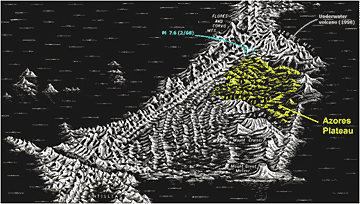
topographical map of the Azores, a chain of islands in the central Atlantic, in the same location Cayce had placed the main island of Atlantis that remained after the first destruction, which he referred to as "Poseidia". Note the topography is much higher than the surrounding ocean floor, much more closely resembles above-ground areas on the Earth. Theorists believe that volcanic pressures under the mid-Atlantic ridge were greatly reduced as a result of Atlanteans tapping into their energies, resulting in the entire island sinking beneath the waves.
Great Atlantis had been greatly damaged, but not destroyed by the arrogance of power displayed by the sons of Belial. The majority of the original continent remained, though it was now separated into five lesser islands, the greatest of which was the island of Poseidia. It was here that the Sons of the Law of One remained steadfast in their beliefs in God and their mission to serve mankind. Having been proven clearly right by the disastrous failure of the children of Belial, the Sons of the Law of One continued developing technologies for the betterment of mankind. "In Atlantean land during those periods of greater expansion as to ways, means and manners of applying greater conveniences for the people of the land |
Rate
-
1
View Rating Log
-
|
|
|
|
|
|
|
|
|
| |
|